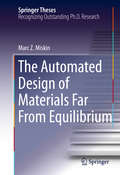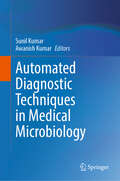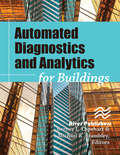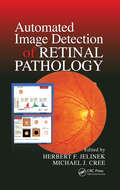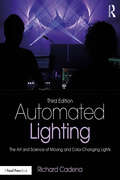- Table View
- List View
The Automated Design of Materials Far From Equilibrium (Springer Theses)
by Marc Z. MiskinThis thesis conceptualizes and implements a new framework for designing materials that are far from equilibrium. Starting with state-of-the-art optimization engines, it describes an automated system that makes use of simulations and 3D printing to find the material that best performs a user-specified goal. Identifying which microscopic features produce a desired macroscopic behavior is a problem at the forefront of materials science. This task is materials design, and within it, new goals and challenges have emerged from tailoring the response of materials far from equilibrium. These materials hold promising properties such as robustness, high strength, and self-healing. Yet without a general theory to predict how these properties emerge, designing and controlling them presents a complex and important problem. As proof of concept, the thesis shows how to design the behavior of granular materials, i.e., collections of athermal, macroscopic identical objects, by identifying the particle shapes that form the stiffest, softest, densest, loosest, most dissipative and strain-stiffening aggregates. More generally, the thesis shows how these results serve as prototypes for problems at the heart of materials design, and advocates the perspective that machines are the key to turning complex material forms into new material functions.
Automated Diagnostic Techniques in Medical Microbiology
by Sunil Kumar Awanish KumarThis book will explore the knowledge of current diagnostic automation techniques applied in the field of clinical microbiology, tropical diseases, POCT, etc. There is no such type of book related to this topic. This book will help clinicians, microbiologists, and researchers to make diagnostic algorithms for infectious diseases and help them in early diagnosis. Automation in clinical microbiology has revolutionized routine practice in diagnostic cum research in medical microbiology. This book covers the recent updates and advances in diagnostic microbiology and provides new techniques related to Genomic, Proteomic, and metabolomics in microbiology. This book will intensely discuss the new and innovative automation techniques available for diagnosis in the microbiology laboratory. This book is more focused on automation techniques, which are used in the early detection of infectious diseases even caused by rare microorganisms. Furthermore, this book has complied with the chapters that provide insights to readers with comprehensive and usable knowledge on automation techniques in diagnostic microbiology.
Automated Diagnostics and Analytics for Buildings
With the widespread availability of high-speed, high-capacity microprocessors and microcomputers with high-speed communication ability, and sophisticated energy analytics software, the technology to support deployment of automated diagnostics is now available, and the opportunity to apply automated fault detection and diagnostics to every system and piece of equipment in a facility, as well as for whole buildings, is imminent. The purpose of this book is to share information with a broad audience on the state of automated fault detection and diagnostics for buildings applications, the benefits of those applications, emerging diagnostic technology, examples of field deployments, the relationship to codes and standards, automated diagnostic tools presently available, guidance on how to use automated diagnostics, and related issues.
Automated Driving: Safer and More Efficient Future Driving
by Daniel Watzenig Martin HornThe main topics of this book include advanced control, cognitive data processing, high performance computing, functional safety, and comprehensive validation. These topics are seen as technological bricks to drive forward automated driving.The current state of the art of automated vehicle research, development and innovation is given. The book also addresses industry-driven roadmaps for major new technology advances as well as collaborative European initiatives supporting the evolvement of automated driving. Various examples highlight the state of development of automated driving as well as the way forward.The book will be of interest to academics and researchers within engineering, graduate students, automotive engineers at OEMs and suppliers, ICT and software engineers, managers, and other decision-makers.
Automated Driving and Driver Assistance Systems
by Tom DentonAutomated vehicles are set to transform the world. Automated driving vehicles are here already and undergoing serious testing in several countries around the world. This book explains the technologies in language that is easy to understand and accessible to all readers. It covers the subject from several angles but in particular shows the links to existing ADAS technologies already in use in all modern vehicles. There is a lot of hype in the media at the moment about autonomous or driverless cars, and while some manufacturers expect to have vehicles available from 2020, they will not soon take over and it will be some time before they are commonplace. However, it is very important to be ready for the huge change of direction that automated driving will take. This is the first book of its type available and complements Tom Denton's other books.
Automated Driving and Driver Assistance Systems
by Tom DentonAutomated vehicles are set to transform the world. Automated driving vehicles are here already and undergoing serious testing in several countries around the world. This book explains the technologies in language that is easy to understand and accessible to all readers. It covers the subject from several angles but in particular shows the links to existing ADAS technologies already in use in all modern vehicles. There is a lot of hype in the media at the moment about autonomous or driverless cars, and while some manufacturers expect to have vehicles available from 2020, they will not soon take over and it will be some time before they are commonplace. However, it is very important to be ready for the huge change of direction that automated driving will take. This is the first book of its type available and complements Tom Denton's other books.
Automated Electronic Filter Design: With Emphasis On Distributed Filters
by Amal BanerjeeThis book describes a novel, efficient and powerful scheme for designing and evaluating the performance characteristics of any electronic filter designed with predefined specifications. The author explains techniques that enable readers to eliminate complicated manual, and thus error-prone and time-consuming, steps of traditional design techniques. The presentation includes demonstration of efficient automation, using an ANSI C language program, which accepts any filter design specification (e.g. Chebyschev low-pass filter, cut-off frequency, pass-band ripple etc.) as input and generates as output a SPICE(Simulation Program with Integrated Circuit Emphasis) format netlist. Readers then can use this netlist to run simulations with any version of the popular SPICE simulator, increasing accuracy of the final results, without violating any of the key principles of the traditional design scheme.
Automated Electronic Filter Design: With Emphasis on Distributed Filters
by Amal BanerjeeThis book describes a novel, efficient and powerful scheme for designing and evaluating the performance characteristics of any electronic filter designed with predefined specifications. The author explains techniques that enable readers to eliminate complicated manual, and thus error-prone and time-consuming, steps of traditional design techniques. The presentation includes demonstration of efficient automation, using an ANSI C language program, which accepts any filter design specification (e.g. Chebyschev low-pass filter, cut-off frequency, pass-band ripple etc.) as input and generates as output a SPICE(Simulation Program with Integrated Circuit Emphasis) format netlist. Readers then can use this netlist to run simulations with any version of the popular SPICE simulator, increasing accuracy of the final results, without violating any of the key principles of the traditional design scheme.
Automated Essay Scoring (Synthesis Lectures on Human Language Technologies)
by Beata Beigman Klebanov Nitin MadnaniThis book discusses the state of the art of automated essay scoring, its challenges and its potential. One of the earliest applications of artificial intelligence to language data (along with machine translation and speech recognition), automated essay scoring has evolved to become both a revenue-generating industry and a vast field of research, with many subfields and connections to other NLP tasks. In this book, we review the developments in this field against the backdrop of Elias Page's seminal 1966 paper titled "The Imminence of Grading Essays by Computer." Part 1 establishes what automated essay scoring is about, why it exists, where the technology stands, and what are some of the main issues. In Part 2, the book presents guided exercises to illustrate how one would go about building and evaluating a simple automated scoring system, while Part 3 offers readers a survey of the literature on different types of scoring models, the aspects of essay quality studied in prior research, and the implementation and evaluation of a scoring engine. Part 4 offers a broader view of the field inclusive of some neighboring areas, and Part \ref{part5} closes with summary and discussion. This book grew out of a week-long course on automated evaluation of language production at the North American Summer School for Logic, Language, and Information (NASSLLI), attended by advanced undergraduates and early-stage graduate students from a variety of disciplines. Teachers of natural language processing, in particular, will find that the book offers a useful foundation for a supplemental module on automated scoring. Professionals and students in linguistics, applied linguistics, educational technology, and other related disciplines will also find the material here useful.
Automated Essay Scoring: A Cross-disciplinary Perspective
by Mark D. Shermis Jill C. BursteinThis new volume is the first to focus entirely on automated essay scoring and evaluation. It is intended to provide a comprehensive overview of the evolution and state-of-the-art of automated essay scoring and evaluation technology across several disciplines, including education, testing and measurement, cognitive science, computer science, and computational linguistics. The development of this technology has led to many questions and concerns. Automated Essay Scoring attempts to address some of these questions including: *How can automated scoring and evaluation supplement classroom instruction? *How does the technology actually work? *Can it improve students' writing? *How reliable is the technology? *How can these computing methods be used to develop evaluation tools? *What are the state-of the-art essay evaluation technologies and automated scoring systems? Divided into four parts, the first part reviews the teaching of writing and how computers can contribute to it. Part II analyzes actual automated essay scorers including e-raterTM, Intellimetric, and the Intelligent Essay Assessor. The third part analyzes related psychometric issues, and the final part reviews innovations in the field. This book is ideal for researchers and advanced students interested in automated essay scoring from the fields of testing and measurement, education, cognitive science, language, and computational linguistics.
Automated Essay Scoring: A Cross-disciplinary Perspective
by Mark D. Shermis Jill C. BursteinThis new volume is the first to focus entirely on automated essay scoring and evaluation. It is intended to provide a comprehensive overview of the evolution and state-of-the-art of automated essay scoring and evaluation technology across several disciplines, including education, testing and measurement, cognitive science, computer science, and computational linguistics. The development of this technology has led to many questions and concerns. Automated Essay Scoring attempts to address some of these questions including: *How can automated scoring and evaluation supplement classroom instruction? *How does the technology actually work? *Can it improve students' writing? *How reliable is the technology? *How can these computing methods be used to develop evaluation tools? *What are the state-of the-art essay evaluation technologies and automated scoring systems? Divided into four parts, the first part reviews the teaching of writing and how computers can contribute to it. Part II analyzes actual automated essay scorers including e-raterTM, Intellimetric, and the Intelligent Essay Assessor. The third part analyzes related psychometric issues, and the final part reviews innovations in the field. This book is ideal for researchers and advanced students interested in automated essay scoring from the fields of testing and measurement, education, cognitive science, language, and computational linguistics.
Automated Fingerprint Identification Systems (AFIS)
by Peter KomarinskiAn easy-to-understand synopsis of identification systems, presenting in simple language the process of fingerprint identification, from the initial capture of a set of finger images, to the production of a Rapsheet. No other single work exists which reviews this important identification process from beginning to end. We examine the identification process for latent (crime scene) prints and how they are identified with these systems. While the primary focus is automated fingerprint identifications, the book also touches on the emergence and use of fingerprints in other biometric systems.Criminal justice administrators, policy makers, and students of forensic science and criminal justice will find a reference to the known limitations and advantages of these systems.This book provides information as to the critical and continual need for properly trained individuals as well as an understanding of the direct and indirect costs associated with maintaining these systems. An understanding of the entire system and what it means will prove invaluable. Why are there missed identifications? Why are identifications made on one database that are not made on another database? Key terms and issues are included, and well as suggestions for improving the overall number of identifications.The book will go beyond process and also discuss issues such as interoperability, management strategies for large databases, contract development, lights out verification and several other issues which impact automated identifications.- The first comprehensive title on this subject area- Outlines in detail the entire process of fingerprint gathering and identity verification - The future of AFIS will is discussed, including national standards in developing multi-agency cooperation/interoperability (U.S.) in addition to the use of AFIS identification world-wide.
Automated Firewall Analytics: Design, Configuration and Optimization
by Ehab Al-ShaerThis book provides a comprehensive and in-depth study of automated firewall policy analysis for designing, configuring and managing distributed firewalls in large-scale enterpriser networks. It presents methodologies, techniques and tools for researchers as well as professionals to understand the challenges and improve the state-of-the-art of managing firewalls systematically in both research and application domains. Chapters explore set-theory, managing firewall configuration globally and consistently, access control list with encryption, and authentication such as IPSec policies. The author also reveals a high-level service-oriented firewall configuration language (called FLIP) and a methodology and framework for designing optimal distributed firewall architecture. The chapters illustrate the concepts, algorithms, implementations and case studies for each technique. Automated Firewall Analytics: Design, Configuration and Optimization is appropriate for researchers and professionals working with firewalls. Advanced-level students in computer science will find this material suitable as a secondary textbook or reference.
Automated Grammatical Error Detection for Language Learners (Synthesis Lectures on Human Language Technologies)
by Claudia Leacock Martin Chodorow Michael Gamon Joel TetreaultIt has been estimated that over a billion people are using or learning English as a second or foreign language, and the numbers are growing not only for English but for other languages as well. These language learners provide a burgeoning market for tools that help identify and correct learners' writing errors. Unfortunately, the errors targeted by typical commercial proofreading tools do not include those aspects of a second language that are hardest to learn. This volume describes the types of constructions English language learners find most difficult -- constructions containing prepositions, articles, and collocations. It provides an overview of the automated approaches that have been developed to identify and correct these and other classes of learner errors in a number of languages. Error annotation and system evaluation are particularly important topics in grammatical error detection because there are no commonly accepted standards. Chapters in the book describe the options available to researchers, recommend best practices for reporting results, and present annotation and evaluation schemes. The final chapters explore recent innovative work that opens new directions for research. It is the authors' hope that this volume will contribute to the growing interest in grammatical error detection by encouraging researchers to take a closer look at the field and its many challenging problems. Table of Contents: Introduction / History of Automated Grammatical Error Detection / Special Problems of Language Learners / Language Learner Data / Evaluating Error Detection Systems / Article and Preposition Errors / Collocation Errors / Different Approaches for Different Errors / Annotating Learner Errors / New Directions / Conclusion
Automated Grammatical Error Detection for Language Learners, Second Edition (Synthesis Lectures on Human Language Technologies)
by Claudia LeacockIt has been estimated that over a billion people are using or learning English as a second or foreign language, and the numbers are growing not only for English but for other languages as well. These language learners provide a burgeoning market for tools that help identify and correct learners' writing errors. Unfortunately, the errors targeted by typical commercial proofreading tools do not include those aspects of a second language that are hardest to learn. This volume describes the types of constructions English language learners find most difficult: constructions containing prepositions, articles, and collocations. It provides an overview of the automated approaches that have been developed to identify and correct these and other classes of learner errors in a number of languages. Error annotation and system evaluation are particularly important topics in grammatical error detection because there are no commonly accepted standards. Chapters in the book describe the options available to researchers, recommend best practices for reporting results, and present annotation and evaluation schemes. The final chapters explore recent innovative work that opens new directions for research. It is the authors' hope that this volume will continue to contribute to the growing interest in grammatical error detection by encouraging researchers to take a closer look at the field and its many challenging problems.
Automated Guided Vehicle Systems: A Primer with Practical Applications
by Günter UllrichThis primer is directed at experts and practitioners in intralogistics who are concerned with optimizing material flows. The presentation is comprehensive covering both, practical and theoretical aspects with a moderate degree of specialization, using clear and concise language. Areas of operation as well as technical standards of all relevant components and functions are described. Recent developments in technology and in the markets are taken into account. The goal of this book is to further stronger use of automated guided transport systems and the enhancement of their future performance.
Automated Guided Vehicle Systems: A Guide - With Practical Applications - About The Technology - For Planning
by Günter Ullrich Thomas AlbrechtThis professional book provides a comprehensive overview of the modern organisational tool of intralogistics. Automated Guided Vehicle Systems (AGV Systems) are floor-based systems that are used internally inside and/or outside of buildings. Since the mid-1990s, AGV Systems have successfully penetrated almost all sectors of industry and many public areas, such as hospitals. The technological standards of all AGV-relevant components and functions are explained and numerous practical examples, e.g. from the automotive, electrical and food industries, are presented. Another focus is the practical planning of such intralogistics systems based on the VDI guidelines, including hints and tips for successful project management when introducing an AGV System. This edition has been completely revised, restructured and reflects the rapid developments in technology and markets.
Automated Hierarchical Synthesis of Radio-Frequency Integrated Circuits and Systems: A Systematic and Multilevel Approach
by Fábio Passos Elisenda Roca Rafael Castro-López Francisco V. FernándezThis book describes a new design methodology that allows optimization-based synthesis of RF systems in a hierarchical multilevel approach, in which the system is designed in a bottom-up fashion, from the device level up to the (sub)system level. At each level of the design hierarchy, the authors discuss methods that increase the design robustness and increase the accuracy and efficiency of the simulations. The methodology described enables circuit sizing and layout in a complete and automated integrated manner, achieving optimized designs in significantly less time than with traditional approaches.
Automated Highway Systems
by Petros IoannouExperts address some of the main issues and uncertainties associated with the design and deployment of Automated Highway Systems (AHS). They discuss new AHS concepts, technology, and benefits, as well as institutional, environmental, and social issues - concerns that will affect dramatically the operation of the current highway system from both the vehicle and infrastructure points of view.
Automated Image Detection of Retinal Pathology
by Herbert Jelinek Michael J. CreeDiscusses the Effect of Automated Assessment Programs on Health Care ProvisionDiabetes is approaching pandemic numbers, and as an associated complication, diabetic retinopathy is also on the rise. Much about the computer-based diagnosis of this intricate illness has been discovered and proven effective in research labs. But, unfortunately, many of
Automated Inspection and Quality Assurance
by Stanley L. Robinson Richard Kendall MillerNew concepts for gaging, inspection, checking, machine vision, and robotic testing. Includes guidelines for installing complex electronic and computerized systems and a directory of commercially availalbe computer software, as well as distributors' names and addresses. Annotation copyright Book News
Automated Inspection and Quality Assurance (Quality And Reliability Ser. #16)
by Stanley L. Robinson Richard Kendall MillerNew concepts for gaging, inspection, checking, machine vision, and robotic testing. Includes guidelines for installing complex electronic and computerized systems and a directory of commercially availalbe computer software, as well as distributors' names and addresses. Annotation copyright Book News
Automated Invention for Smart Industries: 18th International TRIZ Future Conference, TFC 2018, Strasbourg, France, October 29–31, 2018, Proceedings (IFIP Advances in Information and Communication Technology #541)
by Denis Cavallucci Roland De Guio Sebastian KoziołekThis book constitutes the refereed proceedings of the 18th International TRIZ Future Conference on Automated Invention for Smart Industries, held in Strasbourg, France, in October 2018 and sponsored by IFIP WG 5.4.The 27 full papers presented were carefully reviewed and selected from numerous submissions. They are organized in seven thematic sections: teaching of TRIZ; TRIZ and knowledge represenations; biomimicry; strategic company management; association between TRIZ and other methods; TRIZ and the functional approach; and the use of patent or text populations as a data source.
Automated Lighting: The Art and Science of Moving and Color-Changing Lights
by Richard CadenaAutomated Lighting: The Art and Science of Moving and Color-Changing Lights, Third Edition (formerly Automated Lighting: The Art and Science of Moving Light) continues to be the most trusted text for working and aspiring lighting professionals. Now in its third edition, it has been fully updated to reflect the vast changes in stage and studio luminairies—including LEDs, switch-mode power supplies, optics, networking, Ethernet-based protocols like Art-Net and sACN, wireless DMX, and much more. Its written in clear, easy-to-understand language and includes enough detailed information to benefit for the most experienced technicians, programmers, and designers. Additional content and resources are provided at the author's website www.automatedlighting.pro.
Automated Lighting: The Art and Science of Moving and Color-Changing Lights
by Richard CadenaAutomated Lighting: The Art and Science of Moving and Color-Changing Lights, Third Edition (formerly Automated Lighting: The Art and Science of Moving Light) continues to be the most trusted text for working and aspiring lighting professionals. Now in its third edition, it has been fully updated to reflect the vast changes in stage and studio luminairies—including LEDs, switch-mode power supplies, optics, networking, Ethernet-based protocols like Art-Net and sACN, wireless DMX, and much more. Its written in clear, easy-to-understand language and includes enough detailed information to benefit for the most experienced technicians, programmers, and designers. Additional content and resources are provided at the author's website www.automatedlighting.pro.
